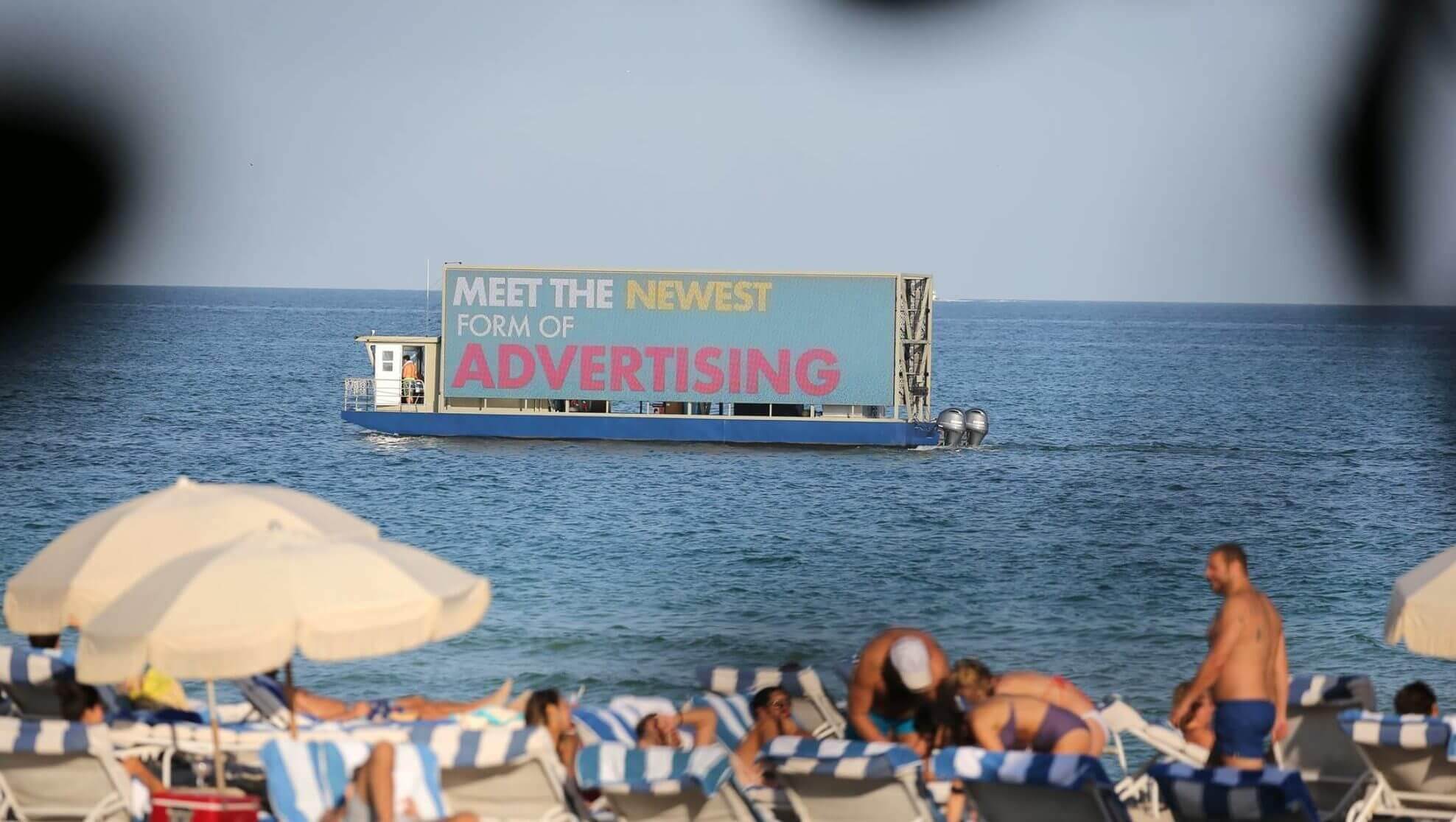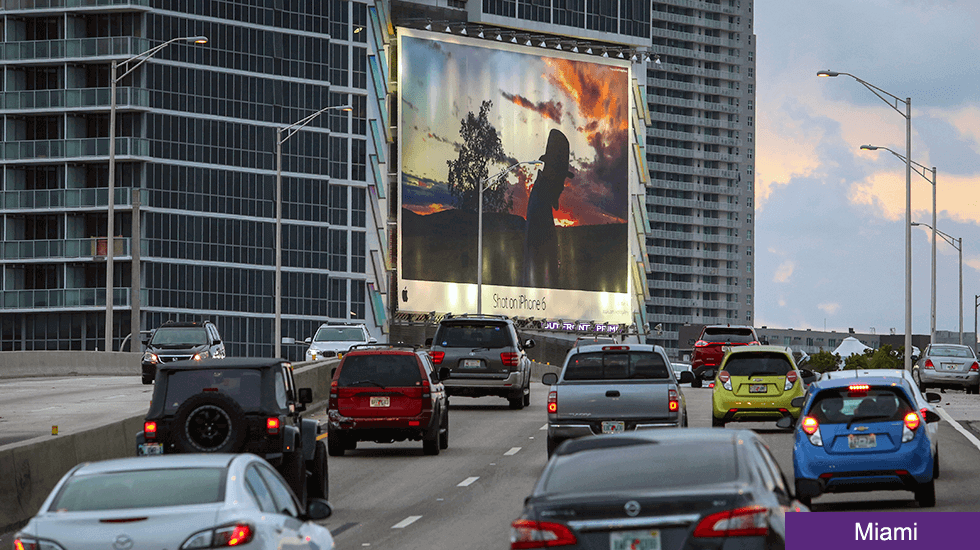
Overview
Conferred as the “cruise capital of the world”, Miami is undeniably a hub of art, culture, finance and international trade. With alluring beaches and a year-round tropical climate, this Magic City attracts a large number of tourists. It’s the most populous county in Florida, with a population of approx. 463,400 people. In areas like Freedom Tower, Bayside Marketplace, Art Deco Historic District, and Bayfront Park, billboard advertising watches over consumers. Miami is the eighth most populous region in the United States, and forms the eleventh largest economy in the world. Let’s take a look at how this popular area utilizes the power of billboards, what the costs look like, why they are successful and upcoming, and how it fares to advertising in other parts of Florida.

Where to Advertise in Miami
Major attractions like Port Miami, Miami Beach and the Civic Center are places so prominent for advertising. One major way to advertise in Miami is along their most populous highways, such as I-75, I-95, I-395. Sports arenas like Sun Life Stadium, which is home to the Miami Dolphins, and Marlins Park, home of the Miami Marlins, allow for digital billboard advertising.
The special facts and figure issue of the Outdoor Advertising Association of America, May 2017, suggests a 2.1% growth rate in OOH advertising. The issue also placed Miami at the 8th position in the list of 2017 top 50 OOH markets by Ad spend with a total of $133,279.7 USD. Though New York and Los Angeles topped the list followed by Chicago, the significance of OOH advertising in Miami cannot be overlooked.
The Comeback of Billboards in Miami
A heart surgeon in Miami by the name of Dr. Joseph Lamelas has his face on an outdoor billboard on the I-95. His goal is to make a comeback in Miami by penetrating the OOH market along the highways. Usually, serious doctors, especially cardiac surgeons, wouldn’t normally advertise themselves on billboards. But now, with the growth of billboards up 3.1 percent to $38 billion and the fall of print ads by 7.2 percent, practitioners, along with other advertisers, are using billboard advertising to appeal to the masses yet again.
Dr. Joseph Lamelas, the new chief cardiac surgeon at the University of Miami Health System, is smart to position his comeback on billboards because of the sheer inflation of advertising effectiveness. 68 percent of people pay attention to roadside billboards and 37 percent read them all. It seems like Dr. Lamelas is heading in the right direction with his practice by displaying his refreshing face on a popular interstate in Miami.
Why Billboard Ads are Successful Here
Miami was ranked as the 10th worst traffic congested city in the world.
Traffic is a term that has certainly redefined billboard ads in Miami. The fussy traffic jams have been looked upon as prospects to gain fame and familiarity for the advertised brands and products. While the consumer is stuck in an annoying traffic congestion, a quick look at an eye-catching billboard ad will obviously be a moment well spent.
“We love a good traffic jam,” said John Miller, vice president of sales and sales operations for Lamar Advertising in Baton Rouge. “We are all about eyeballs on billboards, and the increased amount of traffic is helping us.” (Notte 2018). When in sight, things ought to be in mind and that’s exactly how the OOH advertising boom has evolved.
The billboard ads at Interstate-75, Interstate-95, Interstate-195, Interstate-395, or along the main roads of Miami Avenue, are all spaced within the sight of a large audience. The geography of Miami and locations like the West Palm beach organically home the most culturally diverse population in the country. This city is a perfect connecting point between North America, South America and the Caribbean.
Miami hosts some of the most talked-about high-profile events in United States and drives a vast population of affluent potential consumers. The marketing and business opportunities presented in billboard ads can do wonders in locking the eyes of these consumers.
A great example of an out-of-the-box way to advertise OOH is the floating billboard boats in Miami. These colorful and attractive billboards often come with a unique presentation of the advertised product or brand, and the brand awareness is unmatched.

Types of Billboards in Miami
There are options available for all sorts of billboards, be it digital or static, moving billboards on transit vehicles, or out-of-home like takeovers and wall murals. Billboard ads have left no stone unturned to make the most of public attention. Miami is not shy to advertise in order to gain the best reach possible.
Miami offers a range of billboard types at different prices.
Bulletins (large billboards) are 48’W by 14’H, are located in heavy traffic areas, and cost from $1500-5000 USD per ad/month.
Posters (medium billboards) are 22’8″W by 10’5″H, are available across all markets intending to promote new products and promotions, and cost from $700-3000 USD per ad/month.
Junior posters (small billboards) are 11’W by 5’H, are ideal for targeting specific communities and good for short term ads, and cost from $300-800 USD per ad/month.
Digital billboards are the most expensive way to billboard advertise but they offer more impact. They are 48’W by 14’H, ads rotate usually every 8 seconds and there is no production cost, but it goes for $2500-8000 USD per ad/month.
Transit in Miami
Miami-Dade Transit (MDT), which connects the city from the airport to the downtown core and other major locations, is a hub for mobile billboards. With buses, rails, metro, trolly and metromovers, MDT offers a diverse option for transit as well as for billboard ads. MDT experiments with advertising on the bus interior and exterior, full bus wraps, digital platform network, digital shelters, platform displays, station domination, interior and exterior train advertising, wrapped media, and more. This service is focused on not only getting commuters to and from their given destinations, but providing quality advertising experiences to those people.
Comparing billboards in Florida
Apart form Miami, there are cities like Fort Myers, New Port Richey, Hudson, Orlando and Tampa where billboard ads are popular. Orlando Outdoor Advertising is extremely appealing, specializing in affordable digital billboard ads. However, the attraction of South Florida makes it the most flourishing place for business. South Florida brings in 4.8 million visitors each year.
The crux remains that Miami, being the queen bee of events, art, culture, technology and tourism, posits massive potential for billboard ads empowering brands to take limitless flight. From Port Miami to Civic Center, these ads can reach a staggering number of tourists and locals by drawing them into another piece of culture among all the other wonderful aspects of Miami.
Fitting well in this booming marketing strategy, Movia Media provides quality static mobile billboards for different locations in North America with great services and print quality. Great location, weather, crowd and endless scope for marketing makes Miami a delight for OOH advertising.
References:
Notte, Jason (16 December 2018). Digital Data Gives Billboard Owners More Reason to ‘Love a Good Traffic Jam’. The New York Times. Retrieved from: https://www.nytimes.com/2018/12/16/business/media/billboards-highways-traffic-roads.html
Overview statistics:
(SOURCE: FORBES 2017; U.S. CENSUS 2017; KAUFMANN INDEX 2017)





